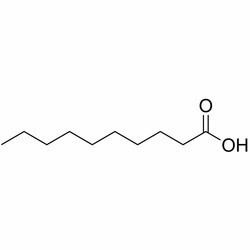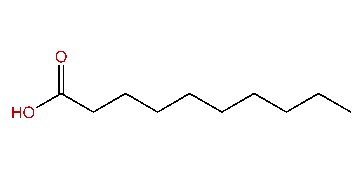Related compounds Molar mass 172.26 g/mol Boiling point 269 °C Appearance White crystals | Formula C10H20O2 Melting point 31.6 °C Density 893 kg/m³ | |
 | ||
Global capric acid market decanoic acid market is expected to reach usd 302 8 million in 2020
Decanoic acid (capric acid) is a saturated fatty acid. Its formula is CH3(CH2)8COOH. Salts and esters of decanoic acid are called decanoates or "caprates". The term capric acid is derived from the Latin "caper / capra" (goat) because the sweaty, unpleasant smell of the compound is reminiscent of goats.
Contents
- Global capric acid market decanoic acid market is expected to reach usd 302 8 million in 2020
- Occurrence
- Production
- Uses
- Pharmaceuticals
- Effects
- References

Occurrence

Capric acid occurs naturally in coconut oil (about 10%) and palm kernel oil (about 4%), otherwise it is uncommon in typical seed oils. It is found in the milk of various mammals and to a lesser extent in other animal fats.

Two other acids are named after goats: caproic (a C6 fatty acid) and caprylic (a C8 fatty acid). Along with decanoic acid, these total 15% in goat milk fat.
Production

Decanoic acid can be prepared from oxidation of primary alcohol decanol by using chromium trioxide (CrO3) oxidant under acidic conditions.
Neutralization of decanoic acid or saponification of its esters, typically triglycerides, with sodium hydroxide will give sodium decanoate. This salt (CH3(CH2)8COO−Na+) is a component of some types of soap.
Uses
Decanoic acid is used in the manufacture of esters for artificial fruit flavors and perfumes. It is also used as an intermediate in chemical syntheses. It is used in organic synthesis and industrially in the manufacture of perfumes, lubricants, greases, rubber, dyes, plastics, food additives and pharmaceuticals.
Pharmaceuticals
Decanoate ester prodrugs of various pharmaceuticals are available. Since decanoic acid is a fatty acid, forming a salt or ester with a drug will increase its lipophilicity and its affinity for fatty tissue. Since distribution of a drug from fatty tissue is usually slow, one may develop a long-acting injectable form of a drug (called a Depot injection) by using its decanoate form. Some examples of drugs available as a decanoate ester include nandrolone, fluphenazine, bromperidol, and haloperidol.
Effects
Decanoic acid acts as a non-competitive AMPA receptor antagonist at therapeutically relevant concentrations, in a voltage- and subunit-dependent manner, and this is sufficient to explain its antiseizure effects. This direct inhibition of excitatory neurotransmission by decanoic acid in the brain contributes to the anticonvulsant effect of the MCT ketogenic diet. Decanoic acid and the AMPAr antagonist drug perampanel act at separate sites on the AMPA receptor, and so it is possible that they have a cooperative effect at the AMPA receptor, suggesting that permapanel and the ketogenic diet could be synergistic.
Decanoic acid may be responsible for the mitochondrial proliferation associated with the ketogenic diet, and that this may occur via PPARγ receptor agonism and its target genes involved in mitochondrial biogenesis.
It should however be noted that orally ingested medium chain fatty acids would be very rapidly degraded by first-pass metabolism by being taken up in the liver via the portal vein, and are quickly metabolized via coenzyme A intermediates through β-oxidation and the citric acid cycle to produce carbon dioxide, acetate and ketone bodies. It is unclear whether the ketones β-hydroxybutryate and acetone have direct antiseizure activity.
